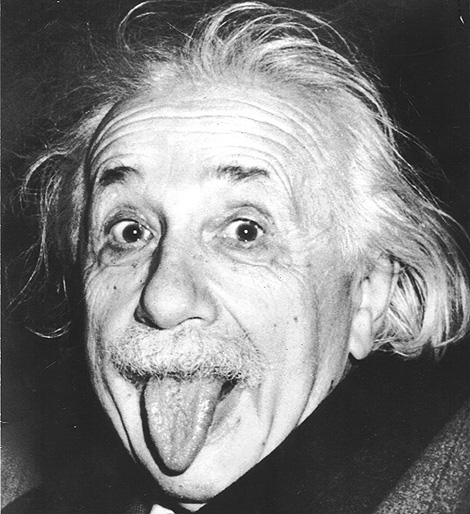A COSMIC SYMPHONY
Welcome to
another science pill in English!
If you
remember from my last post, I recently embarked on a rediscovery of my past as
a science student. My last entry covered several interconnected topics, among
them my reading of a great popular maths book.
Today I
would like to tell you about the one I just finished, entitled The Elegant Universe, by physicist Brian
Greene. Let me just
give you a brief overview of the book’s gist.
Most of you
will recognize this picture of an old fella with his tongue out. As it turns
out, this gentleman revolutionized our understanding of mainly gravity, but
also space, time, all in all, the universe.
Around the
same time Einstein was publishing his theories, specially focused on enormous
things (planets, stars, etc.), particle physics was making groundbreaking
discoveries on a much more minute realm.
Looking at
things on a tinier and tinier scale led to the realization that, apart from
gravity, we also find three other fundamental forces in nature: electromagnetic
force plus weak and strong interactions (responsible for radioactive decay and
for holding most atoms together, respectively).
I’m sure
you’re all familiar with the notion of atoms, that is, the main unit or
constituent of matter. Wherever you lay your eyes on, whatever you see, is made
of atoms. If we go beyond that, atoms are in turn made of smaller particles and
so on until we reach the full inventory that makes up the Standard Model.
This
theory, thanks in great part to quantum mechanics, has been able to describe the
forces I mentioned before as a whole with a sole template except for gravity.
The chasm between the big and the small has fuelled the greatest challenge in
modern science: the creation of a theory of everything able to explain all
physical aspects of the universe.
Going back
to the atoms... Even though the thing is quite complex, for the sake of the
argument, we tend to imagine all particles as little balls that are jiggling in
space. This little point‑like balls are allegedly the building blocks of
everything. But what if I told that our best shot at creating this ultimate
theory relies on something completely different? This is the main subject of
the book.
The
American physicist Brian Greene has been devoting his life to string theory and
in The Elegant Universe he provides
the lay reader with a great introduction to it. String
theory postulates that, instead of the wee points that we usually think of make
up most matter in the cosmos, the actual fundamental components of everything
are minuscule strings cramped in extra dimensions that vibrate through space,
expressing the characteristics of the world that surrounds us.
Just like a
string in a violin vibrating at different frequencies provides different
sounds, the diverse vibration patterns of these strings manifest the features
of the world as in a cosmic symphony. And this, I think, is an extremely
beautiful thing to imagine: what we experience is the music of the universe.
I hope this
mishmash of extra dimensions, wiggly wires and even possible multiverses has
awakened your curiosity. I leave you now with a lecture of the book’s author
that will better illustrate this vision.
Godspeed,
young readers!
Benvidos a unha
nova dose de ciencia en inglés!
Se recordades o
último post, embarqueime recentemente nunha redescoberta do meu pasado como
estudante de ciencias. A miña publicación anterior trataba de varios temas
entrelazados, entre eles a lectura dun gran libro de divulgación matemática.
Hoxe gustaríame falarvos
do novo libro que veño de rematar, O
universo elegante do físico Brian Greene. Para que vos
fagades unha idea a grandes trazos acerca de que trata...
Moitos de vós
recoñeceredes ao homiño coa lingua de fóra da foto anterior. Casualmente, este tipo
revolucionou a nosa comprensión principalmente da gravidade, pero tamén do
espacio, o tempo, en xeral, o universo.
Na mesma época en
que Einstein estaba a publicar as súas teorías, sobre todo centradas en corpos
xigantescos (estrelas, planetas, etc.), a física de partículas facía incríbeis
descubrimentos en dominios microscópicos.
Ollar para as
cousas nunha escala máis e máis diminuta levounos a decatarnos de que, ademais
da gravidade, atopamos na natureza outras tres forzas fundamentais: a
electromagnética e as interaccións débiles e fortes (responsábeis da radioactividade
e de manter os átomos pegados, respectivamente).
Seguro que a
maioría estades familiarizados co concepto de átomos, ou sexa, a unidade primordial
da materia. Calquera cousa ou lugar para o que miredes, está composto de
átomos. Se imos máis aló, os átomos á súa vez están compostos por partículas
máis pequenas e así ata chegar ao inventario total que reflexa o Modelo
Estándar.
Esta teoría, grazas
en gran parte á mecánica cuántica, ten sido capaz de describir todas as forzas que
describín antes como un todo coa única excepción da gravidade. Esta separación
entre a física das cousas pequenas e as enormes ten alimentado o maior desafío
da ciencia moderna: a creación dunha teoría do todo que explique todos os
fenómenos físicos do universo.
Volvendo aos
átomos... A pesar de que a cousa é bastante complexa, por simplificar a
cuestión, normalmente adoitamos pensar nas partículas como boliñas que non acougan
no espazo. Estas pelotas, puntos diríamos, son presuntamente os ladrillos de
todas as cousas. Pero que pasaría se, en realidade, a nosa mellor aposta para
crear esta teoría definitiva recae en compoñentes que son completamente
diferentes? Este é o tema central do libro.
O físico
estadounidense Brian Greene dedicou a súa vida ao desenvolvemento da chamada
teoría de cordas e n’O universo elegante
proporciona unha introdución ao seu traballo para o lector inexperto.
A teoría de
cordas postula que, en lugar deses puntos minúsculos que pensamos que forman a
materia dentro do cosmos, os verdadeiros compoñentes máis fundamentais de todo
son unhas cordas diminutas apachocadas en dimensións extra que vibran no
espazo, expresando a fin de contas as características do mundo que nos rodea.
Do mesmo xeito
que as cordas do violín dan distintos sons ao vibrar en distintas frecuencias,
os patróns de vibración destas cordas manifestas as propiedades do mundo nunha
sorte de sinfonía cósmica. E isto, penso, é unha fermosísima idea: o que
experimentamos é a música do universo.
Espero que estas
papas de dimensións agochadas, fíos en movemento e ata posíbeis multiversos
teña espertado a vosa curiosidade. Déixovos agora cun relatorio do autor que poderá
ilustrar mellor esta visión.
Godspeed, young
readers!









Comentarios
Publicar un comentario